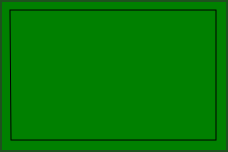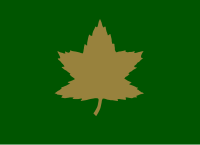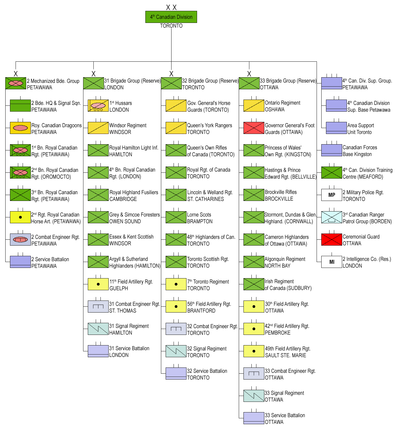| This article needs additional citations for verification. Please help improve this article by adding citations to reliable sources. Unsourced material may be challenged and removed. Find sources: "4th Canadian Division" – news · newspapers · books · scholar · JSTOR (February 2012) (Learn how and when to remove this message) |
| |
|---|---|
 4th Canadian Division formation patch 4th Canadian Division formation patch | |
| Active |
|
| Country | Canada |
| Branch | |
| Type | |
| Size | Division |
| Engagements | |
| Commanders | |
| Notable commanders | |
The 4th Canadian Division is a formation of the Canadian Army. The division was first created as a formation of the Canadian Corps during the First World War. During the Second World War the division was reactivated as the 4th Canadian Infantry Division in 1941 and then converted to armour and redesignated as the 4th Canadian (Armoured) Division. Beginning in 1916 the division adopted a distinctive green-coloured formation patch as its insignia. In 2013 it was announced that Land Force Central Area would be redesignated 4th Canadian Division. It is currently responsible for Canadian Army operations in the Canadian province of Ontario and is headquartered at Denison Armoury in Toronto.
History
First World War
The 4th Canadian Division was formed in Britain in April 1916 from several existing units and others scheduled to arrive shortly thereafter. Under the command of Major-general David Watson, the Division embarked for France in August of that year where they served both in the Western Front in France and in Flanders until Armistice Day. The 4th Canadian Division was a part of the Canadian Corps in the Battle of Vimy Ridge, which attacked and defeated the Germans, driving them from the ridge. As a result, the Canadians became known as masters of offensive warfare and an elite fighting force.
In the Battle of Vimy Ridge in April 1917, the 4th Canadian Division was given the job of capturing Hill 145, the highest and most important feature of Vimy Ridge. However, when they attempted to capture the hill, they were hampered by fire from the "Pimple", which was the other prominent height at Vimy Ridge. To capture Hill 145, forces which were supposed to attack the Pimple were redeployed and captured Hill 145.
Infantry units
- 44th (Manitoba) Battalion Canadian Infantry. April 1916 – 11 November 1918. (Re-designated New Brunswick in August 1918);
- 46th (South Saskatchewan) Battalion Canadian Infantry. April 1916 – 11 November 1918;
- 47th (British Columbia) Battalion Canadian Infantry. April 1916 – 11 November 1918. (Re-designated West Ontario in February 1918);
- 50th (Calgary) Battalion Canadian Infantry. April 1916 – 11 November 1918.
11th Canadian Brigade:
- 54th (Kootenay) Battalion Canadian Infantry. April 1916 – 11 November 1918;
- 75th (Mississauga) Battalion Canadian Infantry. April 1916 – 11 November 1918;
- 87th (Canadian Grenadier Guards) Battalion Canadian Infantry. June 1916 – 11 November 1918 (transferred from 12th Canadian Brigade);
- 102nd (North British Columbia) Battalion Canadian Infantry. April 1916 – 11 November 1918.
12th Canadian Brigade:
- 38th (Ottawa) Battalion Canadian Infantry. June 1916 – 11 November 1918;
- 51st (Edmonton) Battalion Canadian Infantry. April 1916 – 13 November 1916 (Became the 51st Garrison Battalion);
- 72nd Battalion (Seaforth Highlanders of Canada), CEF. April 1916 – 11 November 1918;
- 73rd (Royal Highlanders) Battalion Canadian Infantry. April 1916 – 19 April 1917 (disbanded);
- 78th (Winnipeg Grenadier) Battalion Canadian Infantry. April 1916 – 11 November 1918;
- 85th (Nova Scotia Highlanders) Battalion Canadian Infantry. April 1917 – 11 November 1918;
- 87th (Canadian Grenadier) Battalion Canadian Infantry. April 1916 – June 1916. (transferred to 11th Canadian Brigade).
Pioneers:
- 67th (Western Scot) Pioneer Battalion Canadian Infantry. 1 September 1916 – 11 November 1918;
Battles and Engagements on the Western Front
1916:
- Battle of Le Transloy – 1–17 October
- Battle of the Ancre Heights – 17 October – 11 November, (capture of the Regina Trench)
- Battle of the Ancre – 13–18 November
1917:
- Battle of Vimy Ridge – 9–14 April
- Affairs South of the Souchez River – 3–25 June
- Capture of Avion – 26–29 June
- Battle of Hill 70 – 15–25 August
- Second Battle of Passchendaele – 26 October – 10 November
1918:
- Battle of Amiens – 9–11 August
- Actions round Damery – 15–17 August
- Battle of Drocourt-Quéant – 2–3 September
- Battle of the Canal du Nord 27 September – 1 October
- Battle of Valenciennes 1–2 November 1–2, (capture of Mont Houy)
- Passage of the Grande Honnelle – 5–7 November
Second World War
4th Canadian (Armoured) Division
The 4th Canadian (Armoured) Division was created during World War II by the conversion of the 4th Canadian Infantry Division at the beginning of 1942 in Canada. The division proceeded overseas in 1942, with its two main convoys reaching the United Kingdom in August and October.
The division spent almost two years training in the United Kingdom before crossing to Normandy in July 1944. In the United Kingdom, it participated in war games together with the Polish 1st Armoured Division, and later fought in France, the Low Countries, and Germany; both divisions followed very close paths. The division participated in the later stages of the Battle of Normandy at the Falaise Pocket, the advance from Normandy and spent almost two months engaged at the Breskens Pocket as well as Operation Pheasant. It wintered in the Netherlands and took part in the final advance across northern Germany.
Formation
1944–1945
- 21st Armoured Regiment (The Governor General's Foot Guards)
- 22nd Armoured Regiment (The Canadian Grenadier Guards)
- 28th Armoured Regiment (The British Columbia Regiment (Duke of Connaught's Own))
- The Lake Superior Regiment (Motor)

- 10th Independent Machine Gun Company (The New Brunswick Rangers)
- The Lincoln and Welland Regiment
- The Algonquin Regiment
- The Argyll and Sutherland Highlanders of Canada (Princess Louise's)
- 10 Canadian Infantry Brigade Ground Defence Platoon (Lorne Scots)
- Other units
- 29th Armoured Reconnaissance Regiment (The South Alberta Regiment)
- "D" Squadron, 25th Armoured Delivery Regiment (The Elgin Regiment), Canadian Armoured Corps
- 15th Field Regiment, RCA
- 23rd Field Regiment, RCA
- 5th Anti-tank Regiment, RCA
- 8th Light Anti-aircraft Regiment, RCA
- 4th Canadian Armoured Division Engineers
- 8th Field Squadron, RCE
- 9th Field Squadron, RCE
- 6th Field Park Squadron, RCE
- 4th Canadian Armoured Division Bridge Troop, RCE
- No. 46 Light Aid Detachment, RCEME
- 4th Canadian Armoured Divisional Signals, R.C. Sigs
- No. 4 Defence and Employment Platoon (Lorne Scots)
- 12 Light Field Ambulance, RCAMC
- No. 8 Provost Company, Canadian Provost Corps
Commanding officers
| Date | General officer commanding |
|---|---|
| 10 June 1941 – 24 December 1941 | Major General L.F. Page, DSO |
| 2 February 1942 – 29 February 1944 | Major General F.F. Worthington, CB, MC, MM |
| 1 March 1944 – 21 August 1944 | Major General George Kitching, DSO |
| 22 August 1944 – 30 November 1944 | Major General Harry W. Foster, CBE, DSO |
| 1 December 1944 – 5 June 1945 | Major General Chris Vokes, CBE, DSO |
David Vivian Currie VC
David Vivian Currie VC was awarded the Victoria Cross for his actions in command of a battle group of tanks from The South Alberta Regiment, artillery, and infantry of the Argyll and Sutherland Highlanders of Canada at St. Lambert-sur-Dives, during the final actions to close the Falaise Gap. This was the only Victoria Cross awarded to a Canadian soldier during the Normandy campaign (from 6 June 1944 to the end of August 1944), and the only VC ever awarded to a member of the Royal Canadian Armoured Corps.
The then 32-year-old Currie was a Major in The South Alberta Regiment. During the Battle of Falaise, Normandy, between 18–20 August 1944, Currie was in command of a small mixed force of tanks, self-propelled anti-tank guns and infantry which had been ordered to cut off one of the Germans' main escape routes.
After Currie led the attack on the village of St. Lambert-sur-Dives and consolidated a position halfway inside it, he repulsed repeated enemy attacks over the next day and a half. Despite heavy casualties, Major Currie's command destroyed seven enemy tanks, twelve 88 mm guns and 40 vehicles, which led to the deaths of 300 German soldiers, 500 wounded and 1,100 captured. The remnants of two German armies were denied an escape route.
Gallery
-
 Members of the 4th Canadian (Armoured) Division demonstrating the use of flame throwers across a canal, Maldegem, October 1944.
Members of the 4th Canadian (Armoured) Division demonstrating the use of flame throwers across a canal, Maldegem, October 1944.
-
 Armoured cars in the Belgian-Dutch border town of Putte – 11 October 1944
Armoured cars in the Belgian-Dutch border town of Putte – 11 October 1944
-
 Major David V. Currie (with pistol), accepting the surrender of German troops at St. Lambert-sur-Dives, France, 19 August 1944. This photo captures the actions that led to him being awarded the Victoria Cross
Major David V. Currie (with pistol), accepting the surrender of German troops at St. Lambert-sur-Dives, France, 19 August 1944. This photo captures the actions that led to him being awarded the Victoria Cross
-
 Canadians enter Bergen-op-Zoom, early November 1944
Canadians enter Bergen-op-Zoom, early November 1944
-
 War Memorial in Moerbrugge
War Memorial in Moerbrugge
-
 Plaque on the World War II Memorial in Moerbrugge
Plaque on the World War II Memorial in Moerbrugge
Land Force Central Area and 2013 reactivation
The LFCA was created on 1 September 1991, taking command of what was previously Central Militia Area and the Regular Force Army units and formations in Ontario from the northern Lakehead region to the border with Quebec. At that point in time, the six subordinate militia districts were reorganized into four: Northern Ontario District, London District, Toronto District, and Ottawa District each one garrisoned by a brigade of militia troops and a small number of regular support staff. Later that decade, in 1997, the four reserve force districts were again reorganized into three brigade groups.
At the time of its creation in the early-1990s, it was housed on the grounds of the former base and subsequently moved ca 1993 to the Place Nouveau office tower at Yonge Street north of Finch Avenue; this was controversial as the offices of the area commander, Major-General Brian Vernon, were lavishly renovated, attracting political criticism and attention from the Auditor General of Canada.
In 2013, the LFCA was renamed the "4th Canadian Division". With this change of name, the formation was also granted the identifying patch and historical lineage of the division that fought in the two world wars.
Present day organization
Main article: Structure of the Canadian Army
The division is headquartered in Toronto and covers the province of Ontario.
- 4th Canadian Division, in Toronto
- 2 Canadian Mechanized Brigade Group, at CFB Petawawa
- 31 Canadian Brigade Group, in London (covering Southwestern Ontario)
- 32 Canadian Brigade Group, in Toronto (covering the Golden Horseshoe and Central Ontario)
- 33 Canadian Brigade Group, in Ottawa (covering Eastern Ontario and Northeastern Ontario)
- 4th Canadian Division Headquarters, in Toronto
- 4th Canadian Division Support Group, at CFB Petawawa
- 2 Military Police Regiment, in Toronto
- 2 Intelligence Company (Reserve), in Toronto
- 3rd Canadian Ranger Patrol Group, at CFB Borden
- 4th Canadian Division Training Centre, in Meaford
- Ceremonial Guard, in Ottawa
- Canadian Forces Base Kingston, Kingston
3rd Canadian Ranger Patrol Group
| 3rd Canadian Ranger Patrol Group | CFB Borden | |
|---|---|---|
| 3 Canadian Ranger Patrol Group Headquarters | Regular Support Staff | Borden, Ontario |
| The Attawapiskat Canadian Ranger Patrol | Canadian Rangers | Attawapiskat, Ontario |
| The Bearskin Lake Canadian Ranger Patrol | Canadian Rangers | Bearskin Lake, Ontario |
| The Constance Lake Canadian Ranger Patrol | Canadian Rangers | Constance Lake, Ontario |
| The Eabametoong Canadian Ranger Patrol | Canadian Rangers | Fort Hope, Ontario |
| The Fort Albany Canadian Ranger Patrol | Canadian Rangers | Fort Albany, Ontario |
| The Fort Severn Canadian Ranger Patrol | Canadian Rangers | Fort Severn, Ontario |
| The Kasabonika Lake Canadian Ranger Patrol | Canadian Rangers | Kasabonika Lake, Ontario |
| The Kashechewan Canadian Ranger Patrol | Canadian Rangers | Kashechewan, Ontario |
| The Kingfisher Lake Canadian Ranger Patrol | Canadian Rangers | Kingfisher Lake, Ontario |
| The Kitchenuhmaykoosib Canadian Ranger Patrol | Canadian Rangers | Big Trout Lake, Ontario |
| The Lac Seul Canadian Ranger Patrol | Canadian Rangers | Lac Seul, Ontario |
| The Mishkeegogamang Lake Canadian Ranger Patrol | Canadian Rangers | Mishkeegogamang, Ontario |
| The Moose Factory Lake Canadian Ranger Patrol | Canadian Rangers | Moose Factory, Ontario |
| The Muskrat Dam Canadian Ranger Patrol | Canadian Rangers | Muskrat Dam, Ontario |
| The Neskantaga Canadian Ranger Patrol | Canadian Rangers | Neskantaga, Ontario |
| The Peawanuck Canadian Ranger Patrol | Canadian Rangers | Peawanuck, Ontario |
| The Sachigo Lake Canadian Ranger Patrol | Canadian Rangers | Sachigo Lake, Ontario |
| The Sandy Lake Canadian Ranger Patrol | Canadian Rangers | Sandy Lake, Ontario |
| The North Caribou Lake Canadian Ranger Patrol | Canadian Rangers | North Caribou Lake, Ontario |
| The Wapekeka Detachment of the Kitchenuhmaykoosib Canadian Ranger Patrol | Canadian Rangers | Wapekeka, Ontario |
| The Webequie Canadian Ranger Patrol | Canadian Rangers | Webequie, Ontario |
| The Wunnumin Lake Detachment of the Kingfisher Lake Canadian Ranger Patrol | Canadian Rangers | Wunnumin Lake, Ontario |
Abbreviations
- ASU: Area Support Unit
- CFB: Canadian Forces Base
- RCA: The Royal Regiment of Canadian Artillery
- RCAC: Royal Canadian Armoured Corps
- CFMS: Canadian Forces Medical Service
Commanders
- Brigadier-General C.I. Oberwarth, MSM, CD – 2024 – present
- Brigadier-General J.J. Major, MSM, CD – 2022 – 2024
- Brigadier-General Peter Scott, CD – 2021–2022
- Brigadier-General Conrad Mialkowski, MSM 2019–2021
- Brigadier-General Jocelyn Paul Canadian Forces Organization Orders, MSC, CD – 2018–2019
- Brigadier-General Stephen Cadden CD – 2016–2018
- Brigadier-General Lowell Thomas, CD – 2014–2016
- Brigadier-General Omer Lavoie – 2012–2014
- Brigadier-General Fred Lewis, MSM, CD – 2010–2012
- Brigadier-General Jean-Claude Collin, OMM, CD – 2008–2010
- Brigadier-General John Howard, MSM, CD – 2007–2008
- Brigadier-General Guy Thibault, CD – 2005–2007
- Brigadier-General Greg Young, CD – 2005
- Brigadier-General Marc Lessard, CD – 2003–2005
- Brigadier-General Andrew Leslie, OMM, MSM, CD – 2002–2003
- Brigadier-General Michel Gauthier, CD – 2000–2002
- Colonel Chris Corrigan, CD – 1999–2000
- Brigadier-General Walter Holmes, MBE, MSM, CD – 1998–1999
- Major-General Bryan Stephenson, CD – 1995–1998
- Major-General Brian Vernon, CD – 1993–1995
- Major-General Lewis MacKenzie, CD – 1992–1993
- Major-General Nicholas Hall, CD – 1991–1993
See also
References
- "4th Canadian Armoured Division – Quartermaster Section".
- "www.canadiansoldiers.com". canadiansoldiers.com.
- M.Dorosh (24 July 2013). "CSC: Clarification on the Canadian Army's Historic Insignia Announcement". canadiansoldierscom.blogspot.ca.
- Official LFCA-JTFC Web Site
- Honey, K., (9 April 2002). A once-proud history, slipping away Archived 11 September 2011 at the Wayback Machine. The Globe and Mail. Retrieved on: 2 September 2008.
- ^ "4th Canadian (Armoured) Division". Canadian Soldier. Retrieved 9 August 2012.
- Defence, National (5 November 2018). "The Royal New Brunswick Regiment". www.canada.ca. Retrieved 12 December 2021.
- "www.canadiansoldiers.com". www.canadiansoldiers.com. Retrieved 12 December 2021.
- "Juno Beach Centre – First Canadian Army, 8 May 1945". Junobeach.org. 8 May 1945. Retrieved 13 November 2011.
- "Domestic Military Organization 1900–1999". Canadian Soldiers.com. 22 February 2013.
- "Restoring the Canadian Army's historical identity". Department of National Defence. Archived from the original on 14 July 2013. Retrieved 9 July 2013.
- Government of Canada, National Defence (3 October 2016). "Commander 4th Canadian Division and Joint Task Force Central – Canadian Army". www.army-armee.forces.gc.ca. Retrieved 15 April 2022.
External links
- Battle of Vimy Ridge, April 1917
- Lieutenant Charles Pearson: The Lincoln and Welland Regiment's WWII Campaign
| Field divisions of Canada | |
|---|---|
| Current: | |
| Disbanded: | |
- Divisions of Canada in World War I
- Military units and formations of Canada in World War I
- Military units and formations of Canada in World War II
- Infantry divisions of Canada
- Military units and formations established in 1916
- Military units and formations disestablished in 1919
- Military units and formations established in 1940
- Military units and formations disestablished in 1946
- Military units and formations established in 2013
- 2013 establishments in Canada
- Armored divisions
- Canadian World War II divisions
- Military units and formations of the British Empire in World War II